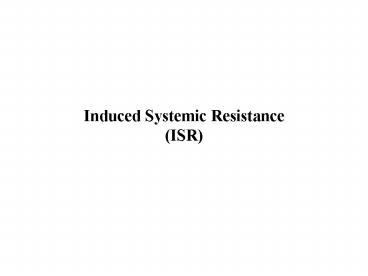Induced Systemic Resistance - PowerPoint PPT Presentation
1 / 19
Title:
Induced Systemic Resistance
Description:
... but involves jasmonic acid and ethylene signaling Systemic acquired resistance is accompanied by induction of pathogenesis related proteins Induced systemic ... – PowerPoint PPT presentation
Number of Views:301
Avg rating:3.0/5.0
Title: Induced Systemic Resistance
1
Induced Systemic Resistance (ISR)
2
ISR SAR PGPR PR (1, 2, 3 etc) Acidic,
basic SA INA NahG JA MeJA jar1 C2H4 ACC ein1 Primi
ng NPR1
1 aminocyclopropane 1 carboxylate
3
Acquired R reported as early as 1933, and
according to Kuc, even earlier. Chester K (1933)
The problem of acquired physiological immunity in
plants. Quar Rev Biol 8 129154,
275324. Terminology clear distinction
between SAR and ISR ca. 1992 Kloepper et al.
(1992) Proposed definitions related to induced
disease resistance. Biocontrol Sci. Technol
2349-351
4
- Definition and observations
- ISR potentiates plant defense responses
- ISR is SA-independent
- ISR is independent of PR gene activation
- ISR requires JA and C2H4 response pathways
- ISR not associated with JA- and C2H4-responsive
gene activation - ISR primes plant for enhanced C2H4 production?
- Summary compare and contrast ISR and SAR
- Discussion
- 1) possible mechanisms of ISR
- 2) selective advantage to plant and practical
significance - Not covered in class
- 1) bacterial determinants of ISR
- 2) field application of ISR
5
Plant-mediated, broad-spectrum resistance
response that is activated by selected strains of
saprophytic rhizosphere bacteria. Many are PGPR.
PGPR colonization non-specific ability to
induce SR has some specificity. Inducing
bacteria and pathogen can be spatially isolated
6
(No Transcript)
7
ISR potentiates plant defense responses
- Fusarium wilt of carnation and radish
- Biocontrol by P. fluorescens WCS358
- Iron competition important sid- mutant not
effective - Biocontrol by P. fluorescens WCS417
- Twice as effective
- Sid-mutant still 100 effective
- Worked when WCS417 and fusarium were spatially
separated on the plant - WCS417 did not trigger phytoalexin accumulation
- WCS417 treated plants produced more phytoalexin
in response to Fusarium
Root rot in bean Accelerated and potentiated
papilla formation
Van Peer et al (1991) Phytopathol 81728-734
8
ISR is SA-independent
W
Fusarium
W
Pieterse et al. (1996) Plant Cell 8, 1225-1237
P. syringae
9
ISR is independent of PR gene activation
Pieterse et al. (1996) Plant Cell 8, 1225-1237
10
ISR requires JA and C2H4 response pathways
etr1 nahG npr1
Pieterse et al. (1998) Plant Cell 10, 1571-158
11
(There may be a) parallel ethylene-inducible
defensive pathway that does not require NPR. A
candidate pathway might be the ethylene-inducible
pathway leading to Pdf1.2 gene expression that
has been shown to be NPR1 independent (Penninckx
et al. 1996 ). Alternatively, this low level of
protection in npr1 plants may be caused by the
twofold higher production of ethylene after ACC
treatment (Figure 2B). However, the latter
possibility seems unlikely because a twofold
increase in ethylene production in wild-type
Col-0 plants, by applying 2.5 mM ACC to the
leaves instead of 1 mM, does not result in a
higher level of protection against P. s. tomato
infection (S.C.M. van Wees, unpublished results).
In itself, the enhanced level of ethylene
production in ACC-treated npr1 plants is
intriguing because it demonstrates that npr1
plants show twofold higher ACC oxidase activity
than do wild-type plants. Interestingly, pathogen
infection also causes a significantly higher
increase in ethylene production in npr1 plants
(C.M.J. Pieterse, unpublished results),
suggesting that not only SA responsiveness but
also ethylene metabolism is altered by the npr1
mutation.
ISR requires JA and C2H4 response pathways in
that order
Pieterse et al. (1998) Plant Cell 10, 1571-158
12
Pieterse et al. (1998) Plant Cell 10, 1571-158
13
?
?
Pieterse et al (2002) Plant Biology 4535-544
14
ISR not associated with JA- and C2H4-responsive
gene activation
So ISR is associated with potentiation of a
specific set of JA-responsive genes? Also,
increased sensitivity rather than increased
production of JA and C2H4 (see also Pieterse et
al. 2000 Physiol. Mol. Plant Pathol. 57123-134)
Pieterse et al. (1998) Plant Cell 10, 1571-158
15
ISR primes plant for enhanced C2H4 production?
ISR plants do not show increased levels of C2H4,
or JA, but ISR activated plants convert more
ACC to C2H4
16
Pieterse et al. WORKING MODEL
Pieterse (2001) Eur. J. Plant Pathol. 10751-61
17
ISR vs. SAR
Induced systemic resistance is induced by
non-pathogenic rhizobacteria
Systemic acquired resistance is induced
systemically after inoculation with necrotizing
pathogens, HR, or application of some chemicals
(SA analogs or agonists)
Induced systemic resistance is independent of
salicylic acid, but involves jasmonic acid and
ethylene signaling
Systemic acquired resistance requires salicylic
acid as signaling molecule in plants
Induced systemic resistance is accompanied by the
expression of sets of genes distinct from the PR
genes
Systemic acquired resistance is accompanied by
induction of pathogenesis related proteins
Both require NPR1
18
(No Transcript)
19
Discussion 1) possible mechanisms of ISR 2)
selective advantage to the plant and practical
significance































